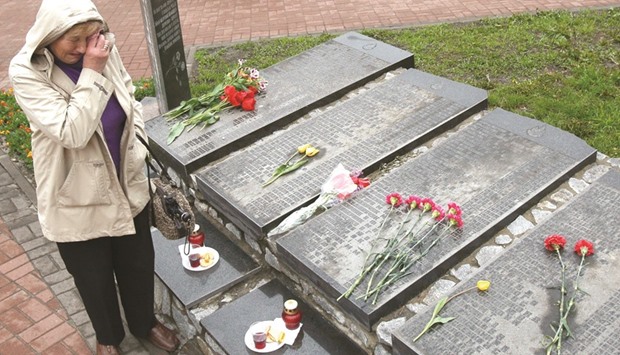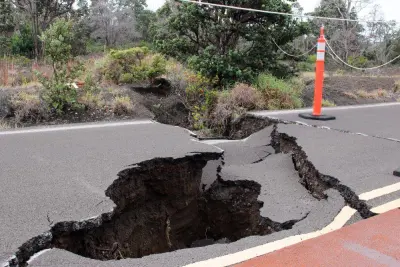Ukrainians held candlelit vigils yesterday to mark 30 years since the world’s worst nuclear accident at Chernobyl spewed radiation across Europe and left several thousand people dead or dying.
Church bells rang and mourners laid flowers at Chernobyl’s memorial square as the clock turned 1.23am – the moment the plant’s reactor number four exploded and changed the fate of a generation living across the former Soviet Union.
“There was crying and screaming,” local pensioner Maria Urupa told AFP as she recalled the terror that struck locals as they watched poisonous clouds of radiation waft in from the plant.
At least 30 people were killed on site and several thousand more are feared to have died from radiation in what Ukrainian President Petro Poroshenko said “appears to have been the world’s largest man-made catastrophe”.
The exact number of dead remains a subject of intense debate because the Soviet authorities kept most of the information about the disaster hidden.
More than 200 tonnes of uranium remain inside the crippled reactor that spattered radiation across three-quarters of Europe after a botched safety test.
Lingering fears of new leaks occurring should the ageing structure covering the toxins crack have prompted a global push to fund the construction of a giant new arch that should keep the site safe for generations.
The UN watchdog the International Atomic Energy Agency (IAEA) used the anniversary to warn against “complacency” in nuclear safety.
The “key lesson” from both Chernobyl and the Fukushima disaster in Japan in 2011 was that “safety can never be taken for granted”, IAEA chief Yukiya Amano said.
But Poroshenko said his country “will not be able to stop using atomic power” as it tries to wean itself off its energy dependence on its former master Russia.
He also warned that Russia’s alleged support for a pro-Moscow insurgency in the east was threatening a repeat of the Chernobyl catastrophe – because Ukraine has its largest nuclear plant on the very edge of the war zone.
“Do not forget that warfare was being waged only a few kilometres from the Zaporizhia nuclear power plant,” Poroshenko said after laying flowers at the dark grey stone plaques honouring those who died trying to contain the 1986 inferno at Chernobyl.
Russia “was planning military activities across most parts of our country, including those with plenty of dangerous facilities”, he said.
Russian parliament speaker Sergei Naryshkin has countered that the former Soviet republic was at fault for operating nuclear plants that had outlived their time of service and were “relying on unauthorised US fuel”.
Chernobyl’s reactor exploded on April 26 and burned for 10 days in a disaster that horrified the world but which locals only heard about through rumours and tidbits from jammed Western radio broadcasts.
The Communist Party kept to its steadfast tradition of saying nothing or lying in order to keep the public from learning of a tragedy that could tarnish the image of the Cold War-era superpower.
International suspicions were only raised on April 28 after Sweden detected an unexplained rise in its own radiation levels.
“Nobody told us anything. There was only silence,” local resident Yevgeny Markevich recalled in an interview with AFP.
It took the authorities a day-and-a-half to evacuate the 48,000 inhabitants from the nearby town of Pripyat.
They eventually relocated 116,000 people that year from the 30km (19-mile) exclusion zone that still surrounds the now-dormant plant.
Some 600,000 people who became known as “liquidators” – mostly emergency workers and state employees – were dispatched with little or no protective gear to help put out the toxic flames and clean up surrounding lands.
A UN report in 2005 estimated that “up to 4,000” people could eventually perish from the invisible poison in Ukraine and neighbouring Russia and Belarus.
The Greenpeace environmental group the next year issued its own study estimating that 100,000 had already lost their lives.
Fears that a structure hastily built over the stricken Chernobyl reactor was cracking saw more than 40 countries pitch in €2.1bn ($2.4bn) for the creation of a new 25,000-tonne protective steel barrier in 2010.
About €165mn more are expected from the Group of Seven world powers and the European Commission.
The giant arch is wide and tall enough to cover the Notre-Dame Cathedral in Paris and weighs three times more than the Eiffel Tower.
Most of the main work has now been completed and the structure is being fitted out with high-tech equipment that – if everything goes according to plan – will be able to decontaminate the hazardous material inside.

A woman cries at the Chernobyl victims’ memorial in Kiev.


